In A Poor Gujarat District, Infrastructure Cannot Compensate For Lack Of Jobs
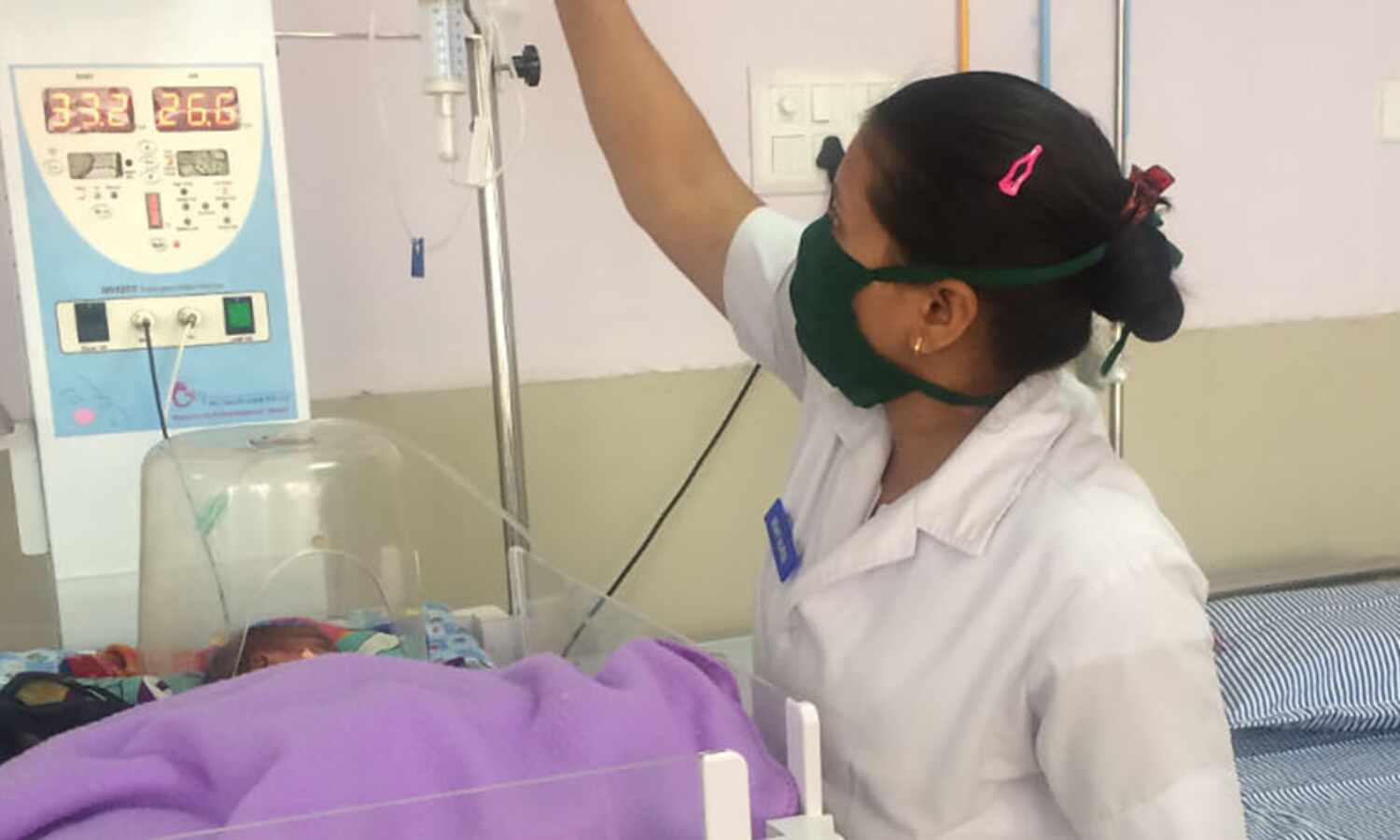
The neonatal intensive unit in Ahwa Civil Hospital has ten warmers and five attending nurses. Even though Dang district’s health infrastructure is better than in several other states, little emphasis on tribal health, limited tribal access to healthcare, and migration which makes it difficult to track women and children, limits improvement in health outcomes of its citizens, we found.
Dang district, Gujarat: “You won’t find many people to talk (to) in our village,” said 50-year-old Gaman Gavit, a farmer from Girmal village near Girmal falls, a tourist spot in South Gujarat’s Dang district, 400 kilometres from the state’s capital Gandhinagar. Two of his four sons migrated to Surat district and Maharashtra to help feed his family of 15, said Gavit, who owns four acres of land on which he grows rice, nagali (finger millet) and vagai (sorghum). About 50 truckloads of people migrate from his village after every monsoon as there are few alternatives to farming, he told IndiaSpend.
As much as 75% of Dang’s population lives under the poverty line of Rs 356 per person a month in villages and Rs 538 per person in cities, and the district struggles to succeed under Gujarat’s development model. In this primarily tribal district--98% belong to the scheduled tribes--48.1% of children under five years were stunted, 72.2% of women were anaemic and only 44.3% of children under two were fully immunised, according to the latest National Family Health Survey of 2015-16 (NFHS-4), even as the district has made investments in health infrastructure.
And it is not just Dang. Gujarat, ranked fifth by per capita income in the country, is ranked 17 among 29 states on infant mortality, with 34 of every 1,000 infants dying every year, worse than much poorer Meghalaya (30), and lower than India’s average infant mortality rate (IMR: deaths per 1,000 births) of 41, as IndiaSpend reported in November 2017. Its neighbouring state of Maharashtra has been able to reduce stunting, wasting in children and improve the health of its mothers, while Gujarat has struggled.
The data present a conundrum: In spite of industrialisation, rising incomes, and investment in infrastructure, health outcomes are poor and there are not enough jobs for the growing population--in India, 280 million will need jobs between now and 2050, the year when the working-age population (15 to 64 years) will peak, IndiaSpend reported in May 2016. This population will have to be healthy and educated to be productive.
“Gujarat never lacked political will to make health a priority,” said Somashekhar Nimbalkar, head of the department of paediatrics at the Pramukhswami Medical College, in Karamsad, Gujarat. “What it lacked is bureaucrats and administrators who would study the problems and offer solutions to political leaders.”
While bridges and providing good water supply can rapidly improve and show results, health programmes need long-term planning and take time to reap benefits. Solutions need to come from the people working on the ground who understand local issues, rather than from high powered committees in locations of power, he explained.
As Gujarat goes to polls on December 9 and December 14, 2017, IndiaSpend visited half a dozen villages in Dang district--one of the six most backward districts of Gujarat--to understand where India and Gujarat’s development model fell short.
Even as Gujarat has grown industrially, a lack of jobs forces people to migrate from Dang, and people don’t access the same benefits they would have accessed in their hometown, it is difficult to access higher levels of education, there is limited emphasis on tribal health and health services and messaging are not adapted to local conditions.
Source: National Family Health Survey, 2015-16 data Gujarat, Dang
| Gujarat’s Health Lags Other Rich States | |||||||
|---|---|---|---|---|---|---|---|
| State | Infant mortality (Deaths/1,000 live births) | Under-five mortality (Deaths/1,000 live births) | Children (12-23 months) fully immunised (In %) | Children < 5 who are stunted (In %) | Children < 5 who are wasted (In %) | Children < 5 who are severely wasted (In %) | Children < 5 who are underweight (In %) |
| Haryana | 33 | 41 | 62.2 | 34 | 21.2 | 9 | 29.4 |
| Maharashtra | 24 | 29 | 56.3 | 34.4 | 25.6 | 9.4 | 36 |
| Punjab | 29 | 33 | 89.1 | 25.7 | 15.6 | 5.6 | 21.6 |
| Gujarat | 34 | 43 | 50.4 | 38.5 | 26.4 | 9.5 | 39.3 |
| Kerala | 6 | 7 | 82.1 | 19.7 | 15.7 | 6.5 | 16.1 |
| Tamil Nadu | 20 | 27 | 69.7 | 27.1 | 19.7 | 7.9 | 23.8 |
Source: National Family Health Survey, 2015-16
Forced migration because of a lack of jobs
Gujarat’s per capita income is Rs 122,502, 39% higher than the Indian average of Rs 82,269, but 75% of Dang’s residents live below the poverty line.
Most people in Dang are dependent on rain-fed subsistence farming of rice, millet, and pulses. Agricultural productivity here is low with 31% of the area under cultivation and 13% of it irrigated, according to a 2013 study by the Aga Khan rural support programme, an Indian non-profit.
In Subir and Waghai blocks of Dang, 48% to 60% of the households migrate seasonally, after the monsoon, the study found. A lack of local employment opportunities in Dang combined with insufficient income forced people to fall in debt traps and migrate to pay off loans to local mukkardams or, labour contractors.
After repaying the mukkardam, there is little money left to send back, said Gavit of Girman village, two of whose sons had migrated for work.
“There are no jobs here, only outsiders come and work here,” said Yohan Thakrey, 18, from the same village. People from other parts of Gujarat work as teachers or government employees, while locals work as agricultural labourers and have to migrate to find jobs, he said.
As people move in search of work, they leave behind government benefits they would have received in Dang, adversely affecting their health. Aadhaar, which provides a unique identification number to every Indian, was formed in part to ensure that people do not lose such benefits when they move, but implementations gaps remain.
The district’s successes: Clean, adequately staffed health centres
When IndiaSpend visited the health sub-centre at Dhawlidod, Ayurveda, Yoga, Naturopathy, Unani, Siddha, Homeopathy (AYUSH) doctor Priyanka Patel was in the outpatient department (OPD). Under the Arogya Setu programme of the government, launched to set-up a dispensary in each village, doctors conduct a general OPD in sub-centres two days a week, she said.
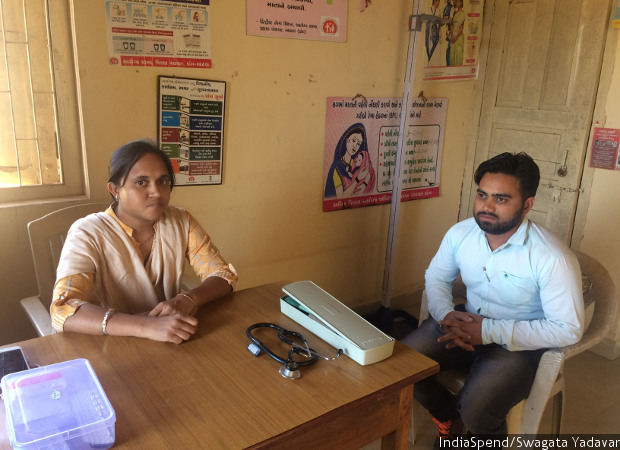
Like most other sub-centres in the district, the sub-centre at Dhawlidod was clean, well maintained, adequately staffed and well-stocked with drugs.
Like most other sub-centres in the district, this sub-centre was clean, well maintained and adequately staffed. It was well-stocked with drugs and there were 76 pregnant women registered with the sub-centre, said multipurpose health worker Abdul Fakir. There were no patients the afternoon IndiaSpend visited, but a fair number of people come for Mamta Divas, the village health and nutrition day every Monday and Wednesday, when women and children are immunised.
“The health facilities at Ahwa have come a long way,” said Usha Valand, the auxiliary nurse and midwife who has been working at the Ahwa Civil Hospital since 1998. The hospital was rebuilt two years ago. Far more women have institutional deliveries now and there is awareness about immunisation, she said. She showed us the cold storage for vaccines that could be monitored ‘from Delhi’ in order to preserve it at the right temperature. The hospital had two paediatricians, one orthopaedic and one dental surgeon working when we visited. It also had a neonatal intensive unit with ten warmers and five attending nurses.
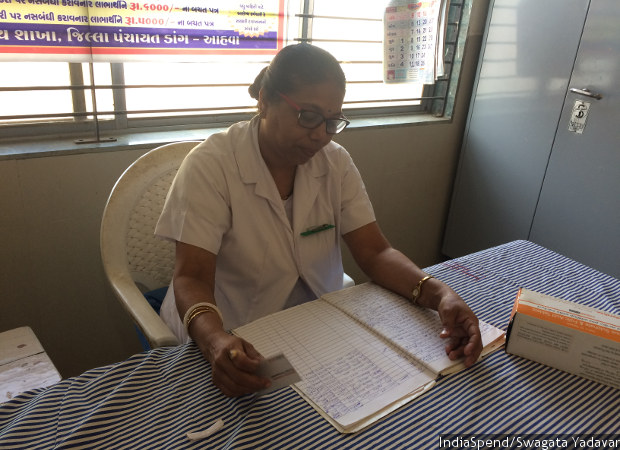
“The health facilities at Ahwa have come a long way,” said Usha Valand, the auxiliary nurse and midwife who has been working at the Ahwa Civil Hospital since 1998.
So confident is Valand of the services here that she is bringing her own daughter from Vadodara to Ahwa for her delivery, she told us.
Patients agree. “Our ASHA [accredited social health activist] dropped us to the hospital, and they are taking good care of me and my son,” said Daksha Choudhari, 27, who came from Chikhli, 20 km away. She said she had a bank account and knew about the benefits of the Janani Swasthya Yojana, a safe motherhood intervention that incentivises institutional deliveries by giving mothers cash.
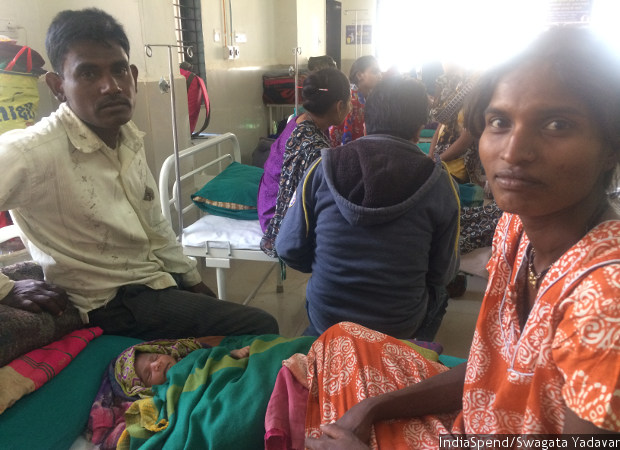
“Our ASHA dropped us to the hospital, and they are taking good care of me and my son,” said Daksha Choudhari, 27, who had come to the Ahwa Civil Hospital from Chikhli, 20 km away.
In the OPD, we met some patients who had travelled to the hospital from Maharashtra for eye surgeries. Good quality care and free treatment motivated us to travel three hours and spend Rs 3,000, said Vilas Gawli, who came to the hospital with his grandmother and father, 150 km from Dhule district in Maharashtra.
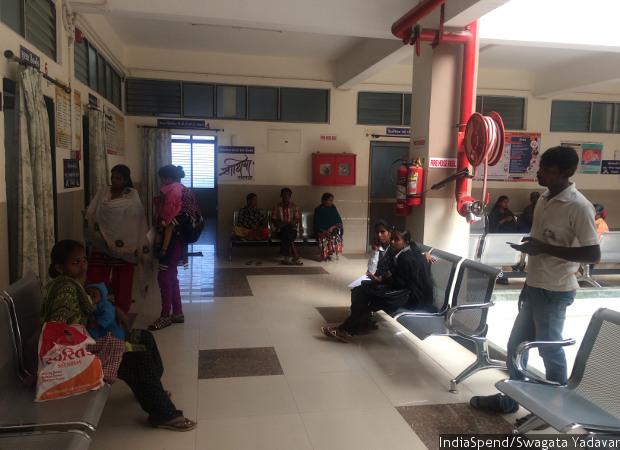
The out-patient department at the Ahwa Civil Hospital.
“I am focussed on improving the immunisation cover,” said Megha Mehta, the district’s new health officer. “A month ago 89% of the children under one year were fully immunised; in the last one month, it has improved to 99%.” These numbers are from e-Mamta--a mother and child tracking system of the Gujarat government. It is based on pregnancies registered in this system, and may miss other institutional deliveries, and deliveries that do not happen in a health care centre. Overall in Dang district, 44.3% of children under two years were fully immunised in 2015-16, according to central government data, compared to the India average of 62%.
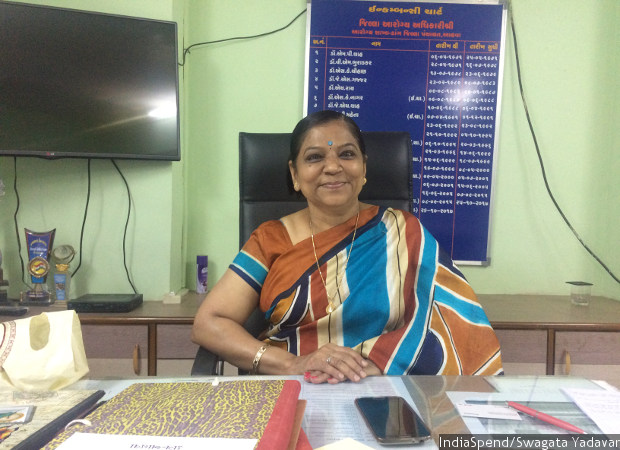
“A month ago 89% of the children under one year were fully immunised; in the last one month, it has improved to 99%,” Megha Mehta, Dang district’s new health officer, told us.
Not all health centres are as good. At Garkhadi primary health centre (PHC), there was no telephone connection or mobile phone network, which means the parked ambulance is put to little use. By January, there is little water left in the village. When IndiaSpend visited the PHC, around 5 pm, there was no doctor. Medical officers find the living quarters in the PHC unfit to stay, so they commute from bigger towns and there is rarely a doctor available after 5 pm, according to the accountant and the security staff at the PHC. IndiaSpend was unable to reach a doctor for comment.
Little emphasis on tribal health
In spite of the good health infrastructure and health resources, Dang has one of the worst health indicators in the state.
One of the reasons could be that tribal populations--about 15% of Gujarat’s population is tribal compared to 8% of the Indian population--have lower access to such services. Poor women belonging to scheduled tribes were 5.32 times less likely to use antenatal care (ANC) services than the non-poor from other castes, a 2013 study that analysed the use of ANC among young mothers in a district-level health survey found. Even non-poor scheduled tribe women were 2.37 times less likely to use the service than other castes, the study found.
“It is not enough to focus on adjusting the health system. Even introducing and strengthening ‘demand-side’ interventions designed to encourage use of maternal health services, such as conditional cash transfers and voucher schemes will not be enough to affect changes in use of services in some groups. More comprehensive structural changes are needed to address other factors such as gender and social norms, political influence, corruption, and discrimination,” the study noted.
Still, medical colleges in Gujarat, including the department of community medicine, is apathetic towards tribal health initiatives, according to Kandarp Talati, the director of Promotion of Action Research, Foundation for Diffusion of Innovations, which works in the tribal district of Dahod in Gujarat.
“There is very little health counselling and health messaging adapted to local practices and customs. For example, health workers talk about breastfeeding within one hour of birth but do not mention that mothers should refrain from giving goat milk which is a prevalent practice here,” he explained.
“We found ASHAs not using their knowledge in their own households, so they also failed in communicating the messages in their communities,” said Nimbalkar who, along with Talati, conducted a study on the level of knowledge of health workers.
Migration makes it difficult to track women, children
Entire families migrate for work from Dang, making it difficult for Anganwadi workers to track their children’s immunisation schedule and for ASHAs to register pregnancies.
Large scale seasonal migration of entire households forces children to join the labour force at the age of six to seven years, and they leave school to become full-fledged labourers by the age of 11-12 years, and girls have to take care of younger siblings and do household chores, according to a 2013 study on children of migrant labourers from Dang. Children miss out on school years, receive no immunisation, no nutritious food and spend time in unsafe work environments, the study noted.
Difficult to access higher levels of schooling
In 2016, 74.8% of men in Dang were literate, compared to 85.7% in India, and 56.9% of women were literate, compared to 68.4% in India. But only 16.3% of women in 2015-16 had more than ten years of education, according to data from NFHS-4, compared to 35.7% in India. A child born to a mother who can read is 50% more likely to survive past five years of age, and each year of mother’s schooling decreases the probability of infant mortality by 5-10%, according to a 2011 report by the United Nations Educational, Scientific and Cultural Organization.
While local schools have residential facilities for children whose parents migrate, the village of Girmal, where Gavit lives, only has a government primary school. Gavit said he spent Rs 6,000 to get one of his grandchildren in the school at Pipaldahad, a nearby village. Now he doesn’t have the money to educate his 14-year-old granddaughter and 15-year-old grandson.
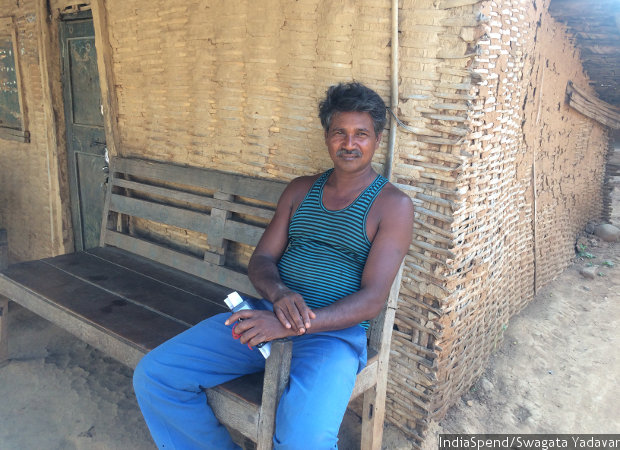
Fifty-year-old Gaman Gavit, a farmer from Girmal village, spent Rs 6,000 to get one of his grandchildren in the school at Pipaldahad, a nearby village. Girmal only has a government primary school.
“The teachers (in local schools) aren’t locals. They stay in towns like Dharampur and Wajda and travel two hours to reach the village. By the time they reach here, they are exhausted so they aren’t keen to teach,” said grocery shop-owner Sanjay Raut, 37, from Gaodahad village. There are very few students from local schools who pass grade X in the first attempt. This is why he sent his daughter to study in a residential school, 116 km away, he told IndiaSpend.
Several problems exist on the ground, but most Dang residents remain apolitical
For all their lives, Ramabhai Gadhar, 60, and his wife, have been trekking 14 km uphill to reach their daughter’s house in Girmal from Dhulda village. Dhulda has no road to nearby villages. Though there is an ASHA in the village, the nearest health centre is 4 km away, and the village is completely cut-off during the monsoon when the river floods. “We want a bridge,” Gadhar said, but was non-committal about whom he would vote for this election.
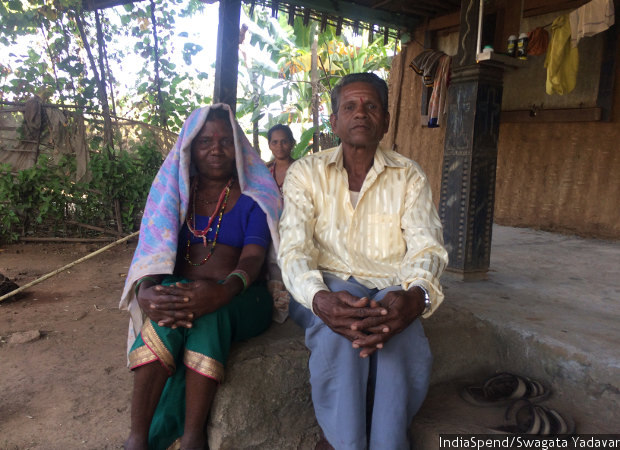
For all their lives, Ramabhai Gadhar, 60, and his wife, have been trekking 14 km uphill to reach their daughter’s house in Girmal from Dhulda village. Dhulda has no road to nearby villages. “We want a bridge,” Gadhar said, but was non-committal about whom he would vote for this election.
The district looked apolitical; there were no political banners, posters or even flags in the villages. Most villagers said they weren’t affiliated to one party but added that they hadn’t seen their member of legislative assembly (MLA) since the last election. Some said they would vote for whoever paid them.
In 1997, the district had grabbed headlines for violent attacks against Christians by right wing groups opposed to what they said were “forced conversions”. Villagers are still wary of talking about religion and political affiliation with outsiders.
Since 2012, Mangalbhai Gavit from the Congress party has been the district’s MLA, after defeating Bharatiya Janata Party’s Vijaybhai Patel by a margin of 2,422 votes. This year too Gavit and Patel are contesting the elections.
Next: What Surat’s Health Transformation Can Teach Other Cities
(Yadavar is a principal correspondent with IndiaSpend.)
We welcome feedback. Please write to respond@indiaspend.org. We reserve the right to edit responses for language and grammar.


